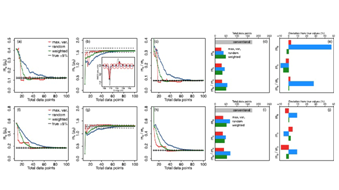 Adaptive design of an X-ray magnetic circular dichroism spectroscopy experiment with Gaussian process modelling (高斯过程建模的X射线磁性圆二色光谱实验的自适应设计)
Adaptive design of an X-ray magnetic circular dichroism spectroscopy experiment with Gaussian process modelling (高斯过程建模的X射线磁性圆二色光谱实验的自适应设计)
Tetsuro Ueno, Hideitsu Hino, Ai Hashimoto, Yasuo Takeichi, Masahiro Sawada & Kanta Ono
npj Computational Materials 4:4 (2018)
doi:10.1038/s41524-017-0057-4
Published online:25 January 2018
Abstract| Full Text | PDF OPEN
摘要:光谱学是一种应用广泛的实验技术,提高其效率可对材料研究产生重大影响。本研究提出了一个光谱实验的自适应设计:用机器学习技术来提高其效率。我们考查了机器学习技术应用于X射线磁圆二色谱(XMCD)的适用性。首先采用有限数量的测量数据点供机器学习实验光谱,进而利用高斯过程建模预测XMCD光谱。通过对预测光谱的最大方差的数据点进行自适应采样,成功地减少了用于评估磁矩的数据点数目,同时提供了所需的精度。本方法减少了采用XMCD光谱测量的时间和花费,并可能适用于各种光谱学研究。
Abstract:Spectroscopy is a widely used experimental technique, and enhancing its efficiency can have a strong impact on materials research. We propose an adaptive design for spectroscopy experiments that uses a machine learning technique to improve efficiency. We examined X-ray magnetic circular dichroism (XMCD) spectroscopy for the applicability of a machine learning technique to spectroscopy. An XMCD spectrum was predicted by Gaussian process modelling with learning of an experimental spectrum using a limited number of observed data points.
Adaptive sampling of data points with maximum variance of the predicted spectrum successfully reduced the total data points for the evaluation of magnetic moments while providing the required accuracy. The present method reduces the time and cost for XMCD spectroscopy and has potential applicability to various spectroscopies.
Editorial Summary
Spectroscopy: Machine learning for efficient measurements (光谱学:机器学习助力高效测定)
机器学习方法可以使光谱学方法更具时间和成本效益。光谱学是表征材料性能的一种强有力的实验技术,但测量时间往往很长,导致使用成本较高。根据所用光谱波长的不同,光谱学方法分为很多种类。现在,日本研究者Tetsuro Ueno和Kanta Ono等提出,利用机器学习方法可以减少X射线磁圆二色光谱确定材料中磁矩时所需数据点的数量。这种基于模型预测反复调整实验取样的方法,不仅减少了此类光谱学测量的时间和成本,亦可应用于其他光谱测量方法。
Machine learning methods can make spectroscopy more time- and cost-efficient. Spectroscopy is a powerful experimental technique for characterising the properties of materials, but measurement times can often be long resulting in high running costs. There are many different types of spectroscopy, using light at different wavelengths. A team of Japanese researchers led by Tetsuro Ueno and Kanta Ono now show that machine learning methods can be used to reduce the number of data points required to determine the magnetic moments in a material using x-ray magnetic circular dichroism spectroscopy. This method, which repeatedly adapts the experimental sampling based on model predictions, not only reduces the time and cost for this type of spectroscopy, but it should be applicable to others.


 沪公网安备 31010502006565号
沪公网安备 31010502006565号